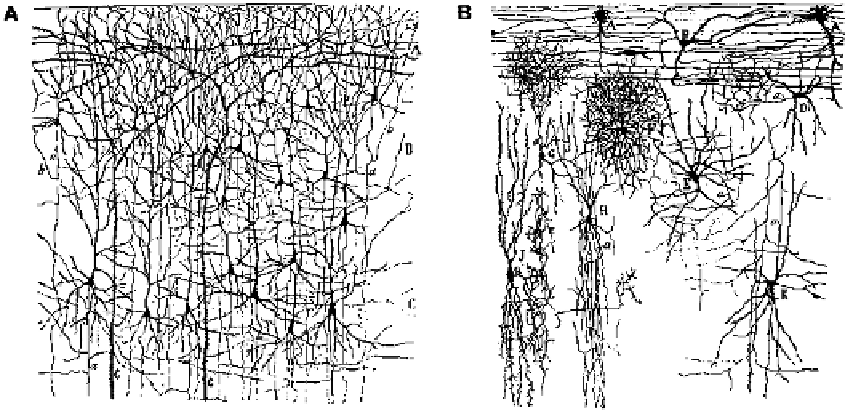Information Technology Reference
In-Depth Information
Figure 3.1:
Images of the neural structure of the cortex. A) shows the dense web of connectivity among pyramidal neurons. B)
shows a number of the other different neuron types, including chandelier and basket interneurons. Reproduced from
Crick and
Asanuma (1986).
The input layer corresponds to cortical layer 4, which
usually receives the sensory input by way of a subcor-
tical brain area called the
thalamus
, which receives in-
formation from the retina and other sense organs. The
output layer corresponds to the
deep
cortical layers 5
and 6, which send motor commands and other outputs
to a wide range of subcortical areas, including the
basal
ganglia
. The hidden layer corresponds to the
superfi-
cial
(upper) cortical layers 2 and 3 (cortical layer 1 is
largely just axons). These layers receive inputs locally
from the other cortical layers and also from other more
distant superficial cortical layers. The superficial layers
usually project outputs back to these same more distant
cortical areas, and to the deep (output) layers locally.
We view the role of the hidden layer (so named be-
cause it is not directly “visible” (connected) to either
the noncortical input or output areas) as mediating the
transformation from input to output. As we will see in
the next section (and throughout the remainder of the
text), much of what goes on in cognition can be thought
of in terms of transforming input patterns in ways that
emphasize some distinctions and deemphasize others.
Having one or more hidden layers intervening between
the input and the output allows much richer and more
complex transformations to be computed, which in turn
enables much “smarter” behavior.
Essentially the same functional classification of the
cortical layers was suggested as long ago as Bolton
(1910) and is supported by several different types of
data. First, the anatomical connectivity between the
different areas (e.g., White, 1989a; Zilles, 1990) sug-
gests that information coming into the input layer is
next transmitted primarily to the hidden layer, and then
on to the output layer (figure 3.3). In addition, record-
ings of the firing properties of neurons in the different
cortical layers shows that the hidden and output layer
neurons have more complex responses than those in the
input layers (reviewed in White, 1989a).
Nevertheless, it is difficult to be certain of exactly
what is connected to what in the cortex. One compli-
cation is that the dendrites of neurons extend over mul-
tiple cortical layers (figure 3.1), so one would need to
identify not only what layer an input projection termi-
nates in, but also which specific sets of neurons actually
receive that input. Although this has been done in some
cases, it is exceedingly difficult and tedious work, and

Search WWH ::

Custom Search